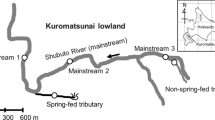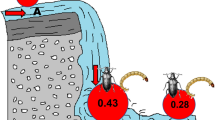Abstract
We examined the spatial structure of macroinvertebrate assemblages in surface-flowing waters of a glacially-influenced floodplain. The floodplain main-channel responded longitudinally to changes in hydrology with evident coarse-scale zones of upwelling and downwelling; the lower floodplain main channel fell dry in late winter. Physico-chemical attributes differed among tributaries and the main channel. The main channel had lower values of conductivity, alkalinity and nitrate–N than tributaries, with right-side (east-facing) tributaries having the highest values. Left-side (west-facing) tributaries flowing over an exposed rock-face had warmer water temperatures than the main channel and right-side tributaries. The biomass of benthic organic matter and periphyton was highest in right-side tributaries, followed by main channel sites then left-side tributaries. Similarly, macroinvertebrate density and richness were higher in right-side tributaries, intermediate in main channel sites, and lowest in left-side tributaries. Macroinvertebrate assemblages clearly differed between main channel sites, right-side tributaries, and left side tributaries based on an NMDS analysis. Minor differences were observed among main channel sites, although most upstream sites showed some structural differences from downstream sites. Ephemeropterans and plecopterans were most common in main channel sites and right-side tributaries, whereas chironomids and trichopterans also were common in right-side tributaries. Although the main channel changed longitudinally in physico-chemical characteristics, no real patterns of zonation were evident in macroinvertebrate assemblages. Coarse spatial patterns in macroinvertebrate assemblages in the floodplain were reflected in the physico-chemical differences between the main channel and tributaries, and between left-side and right-side tributaries. We conclude that coarse-scale floodplain properties enhance the overall diversity of lotic macroinvertebrates. Consequently, floodplain alterations that reduce surface water heterogeneity/connectivity limits the potential macroinvertebrate diversity of floodplains.






Similar content being viewed by others
References
Arscott DB, Tockner K, Ward JV (2000) Aquatic habitat diversity along the corridor of an alpine floodplain river (Fiume Tagliamento, Italy). Archiv für Hydrobiologie 149:679–704
Arscott DB, Tockner K, Van der Nat D, Ward JV (2002) Aquatic habitat dynamics along a braided alpine river ecosystem (Tagliamento River, Northeast Italy). Ecosystems 5:802–814
Bodmer P (2011) Habitat heterogeneity, respiration and microbial dynamics: the alpine floodplain of the Urbach. Msc. thesis, University of Basel, Switzerland
Boulton AJ, Datry T, Kasahara T, Mutz M, Stanford JA (2010) Ecology and management of the hyporheic zone: stream-groundwater interactions of running waters and their floodplains. J N Am Benthol Soc 29:26–40
Brown LE, Milner AM, Hannah DM (2007) Groundwater influence on alpine stream ecosystems. Freshw Biol 52:878–890
Brunke M, Gonser T (1997) The ecological significance of exchange processes between rivers and groundwater. Freshw Biol 37:1–33
Doering M, Uehlinger U, Rotach A, Schlaepfer DR, Tockner K (2007) Ecosystem expansion and contraction dynamics along a large alpine alluvial corridor (Tagliamento River, Northeast Italy). Earth Surf Proc Land 32:1693–1704
Doering M, Blaurock M, Robinson CT (2012a) Landscape transformation of an alpine floodplain influenced by humans: historical analyses from aerial images. Hydrol Proces 26:3319–3326
Doering M, Uehlinger U, Tockner K (2012b) Vertical hydrological exchange, ecosystem properties and processes at two spatial scales along a floodplain river (Tagliamento, Italy). Freshw Sci (in press)
Frissell CA, Liss WJ, Warren CE, Hurley MD (1986) A hierarchical framework for stream habitat classification: viewing streams in a watershed context. Environ Manage 10:199–214
Gray D, Harding JS (2007) Braided river ecology: a literature review of physical habitats and aquatic invertebrate communities. Science for Conservation publication, p 279
Gregory SV, Swanson FJ, Mckee WA, Cummins KW (1991) An ecosystem perspective of riparian zones. Bioscience 41:540–551
Hieber M, Robinson CT, Uehlinger U (2003) Seasonal and diel patterns in invertebrate drift in different types of alpine streams. Freshw Biol 48:1078–1092
Hieber M, Robinson CT, Uehlinger U, Ward JV (2005) A comparison of benthic macroinvertebrate assemblages among different types of alpine streams. Freshw Biol 50:2087–2100
Junk WJ (1989) The flood pulse concept in river-floodplain systems. Can Spec Publ Fish Aquat Sci 106:110–126
Larned S, Datry T, Robinson CT (2007) Invertebrate and microbial responses to inundation in an ephemeral river reach in New Zealand: effects of preceding dry periods. Aquat Sci Res Across Boundaries 69:554–567
Malard F, Uehlinger U, Zah R, Tockner K (2006) Flood-pulse and riverscape dynamics in a braided glacial river. Ecology 87:704–716
Milner AM, Brittain JE, Castella E, Petts GE (2001) Trends of macroinvertebrate community structure in glacial-fed rivers in relation to environmental conditions: a synthesis. Freshw Biol 46:1833–1847
Paetzold A, Schubert CJ, Tockner K (2005) Aquatic terrestrial linkages along a braided-river: riparian arthropods feeding on aquatic insects. Ecosystems 8:748–759
Platts WS, Megahan WF, Minshall GW (1983) Methods for evaluating stream, riparian, and biotic conditions. Gen. Tech. Rep. INT-138, Ogden, Utah: U.S. Dept. of Agriculture, Forest Service, Intermountain Forest and Range Experiment Station
Robinson CT, Matthaei S (2007) Hydrological heterogeneity of an Alpine stream/lake network in Switzerland. Hydrol Process 21:3146–3154
Robinson CT, Uehlinger U, Hieber M (2001) Spatial and temporal variation in macroinvertebrate assemblages of glacial streams in the Swiss Alps. Freshw Biol 46:1663–1672
Robinson CT, Tockner K, Burgherr P (2002a) Seasonal patterns in macroinvertebrate drift and seston transport in streams of an alpine glacial flood plain. Freshw Biol 47:985–994
Robinson CT, Tockner K, Ward JV (2002b) The fauna of dynamic riverine landscapes. Freshw Biol 47:661–677
Robinson CT, Tockner K, Burgherr P (2004) Drift benthos relationships in the seasonal colonization dynamics of alpine streams. Archiv für Hydrobiologie 160:447–470
Rüegg J, Robinson CT (2004) Comparison of macroinvertebrate assemblages of permanent and temporary streams in an Alpine flood plain, Switzerland. Archiv für Hydrobiologie 161:489–510
Southwood TRE (1977) Habitat, the templet for ecological strategies. J Anim Ecol 46:337–365
Stanford JA, Ward JV (1993) An ecosystem perspective of alluvial rivers—connectivity and the hyporheic corridor. Journal of the North American Benthological Society 12:48–60
Stanford JA, Lorang MS, Hauer FR (2005) The shifting habitat mosaic of river ecosystems. Verhandlungen der Internationalen Vereinigung für Limnologie 29:123–136
Tockner K, Malard F, Burgherr P, Robinson CT, Uehlinger U, Zah R, Ward JV (1997) Physico-chemical characterization of channel types in a glacial floodplain ecosystem (Val Roseg, Switzerland). Archiv für Hydrobiologie 140:433–463
Tockner K, Malard F, Ward JV (2000) An extension of the flood pulse concept. Hydrol Process 14:2861–2883
Tockner K, Pusch M, Borchardt D, Lorang MS (2010) Multiple stressors in coupled river–floodplain ecosystems. Freshw Biol 55:135–151
Van der Nat D, Tockner K, Edwards PJ, Ward JV (2003) Habitat change in braided flood plains (Tagliamento, NE-Italy). Freshw Biol 48:1799–1812
Ward JV (1989) The four-dimensional nature of lotic ecosystems. J N Am Benthol Soc 8:2–8
Ward JV, Tockner K, Arscott DB, Claret C (2002) Riverine landscape diversity. Freshw Biol 47:517–539
Williams DD (1996) Environmental constraints in temporary fresh waters and their consequences for the insect fauna. J N Am Benthol Soc 15:634–650
Zar JH (1984) Biostatistical analysis. Prentice-Hall, New Jersey
Acknowledgments
We thank S. Blaser and C. Jolidon for assistance in the field and processing of samples in the laboratory, and R. Illi for chemical analysis of water samples. We thank S. Schweizer for logistic advice and fruitful discussions regarding the project. Comments by two anonymous reviewers improved the paper presentation. Funding was provided by Kraftwerke Oberhasli (KWO), Swiss Federal Office of the Environment (Bafu), Swiss Federal Office for Regional Development (ARE), and the Graubunden Department of Fish and Game. The paper is a contribution of the EU Int-Reg Project Alp-Water-Scarce, a member of the Alpine Space Program.
Author information
Authors and Affiliations
Corresponding author
Rights and permissions
About this article
Cite this article
Robinson, C.T., Doering, M. Spatial patterns in macroinvertebrate assemblages in surface-flowing waters of a glacially-influenced floodplain. Aquat Sci 75, 373–384 (2013). https://doi.org/10.1007/s00027-012-0283-2
Received:
Accepted:
Published:
Issue Date:
DOI: https://doi.org/10.1007/s00027-012-0283-2




